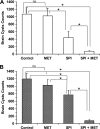Significant reduction of brain cysts caused by Toxoplasma gondii after treatment with spiramycin coadministered with metronidazole in a mouse model of chronic toxoplasmosis
- PMID: 22271863
- PMCID: PMC3318357
- DOI: 10.1128/AAC.05183-11
Significant reduction of brain cysts caused by Toxoplasma gondii after treatment with spiramycin coadministered with metronidazole in a mouse model of chronic toxoplasmosis
Abstract
Toxoplasma gondii is a parasite that generates latent cysts in the brain; reactivation of these cysts may lead to fatal toxoplasmic encephalitis, for which treatment remains unsuccessful. We assessed spiramycin pharmacokinetics coadministered with metronidazole, the eradication of brain cysts and the in vitro reactivation. Male BALB/c mice were fed 1,000 tachyzoites orally to develop chronic toxoplasmosis. Four weeks later, infected mice underwent different treatments: (i) infected untreated mice (n = 9), which received vehicle only; (ii) a spiramycin-only group (n = 9), 400 mg/kg daily for 7 days; (iii) a metronidazole-only group (n = 9), 500 mg/kg daily for 7 days; and (iv) a combination group (n = 9), which received both spiramycin (400 mg/kg) and metronidazole (500 mg/kg) daily for 7 days. An uninfected control group (n = 10) was administered vehicle only. After treatment, the brain cysts were counted, brain homogenates were cultured in confluent Vero cells, and cysts and tachyzoites were counted after 1 week. Separately, pharmacokinetic profiles (plasma and brain) were assessed after a single dose of spiramycin (400 mg/kg), metronidazole (500 mg/kg), or both. Metronidazole treatment increased the brain spiramycin area under the concentration-time curve from 0 h to ∞ (AUC(0-∞)) by 67% without affecting its plasma disposition. Metronidazole plasma and brain AUC(0-∞) values were reduced 9 and 62%, respectively, after spiramycin coadministration. Enhanced spiramycin brain exposure after coadministration reduced brain cysts 15-fold (79 ± 23 for the combination treatment versus 1,198 ± 153 for the untreated control group [P < 0.05]) and 10-fold versus the spiramycin-only group (768 ± 125). Metronidazole alone showed no effect (1,028 ± 149). Tachyzoites were absent in the brain. Spiramycin reduced in vitro reactivation. Metronidazole increased spiramycin brain penetration, causing a significant reduction of T. gondii brain cysts, with potential clinical translatability for chronic toxoplasmosis treatment.
Figures


References
-
- Bailer AJ. 1988. Testing for the equality of area under the curves when using destructive measurement techniques. J. Pharmacokinet. Biopharm. 16:303–309 - PubMed
-
- Brenier-Pinchart MP, et al. 2004. Infection of human astrocytes and glioblastoma cells with Toxoplasma gondii: monocyte chemotactic protein-1 secretion and chemokine expression in vitro. Acta Neuropathol. 107:245–249 - PubMed
-
- Chatterton JM, Evans R, Ashburn D, Joss AW, Ho-Yen DO. 2002. Toxoplasma gondii in vitro culture for experimentation. J. Microbiol. Methods 51:331–335 - PubMed
-
- Chew WK, Wah MJ, Ambu S, Segarra I. 2012. Toxoplasma gondii: determination of the onset of chronic infection in mice and the in vitro reactivation of brain cysts. Exp. Parasitol. 130:22–25 - PubMed
Publication types
MeSH terms
Substances
LinkOut - more resources
Full Text Sources
Medical

